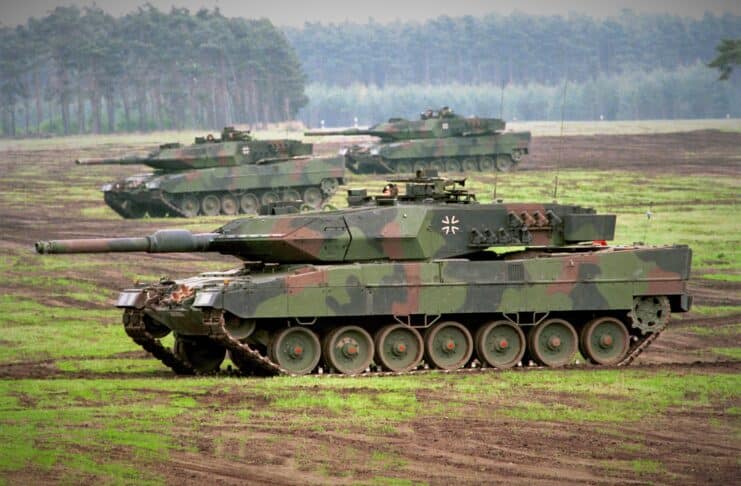ANALYSIS – President Donald Trump was lambasted by the foreign policy elites in both parties when he called Germany delinquent in its commitments to NATO and bashed other allies for not doing enough to defend themselves, while relying on the United States.
But Trump was right to demand more from Europe. He was also right to make his demand clear by removing some U.S. troops and relocating others.
Europe has a GDP equivalent to the United States, and most NATO members weren't reaching the minimum requirement of spending 2% of GDP on defense. After pressure from Trump, defense spending by European allies began to rise.
Then came the Russian invasion of Ukraine and the need for Europe to pay for more of its own defense became crystal clear.
Defense spending in Central and Western Europe rose 13 percent in 2022 to $345 billion, driven by Russia's invasion and increased tensions over Taiwan and North Korea, according to the Stockholm International Peace Research Institute.
Meanwhile, Russia's defense exports crashed. (RELATED: Missile Attack Sets Russian Black Sea Fleet Headquarters Ablaze)

Management consultancy McKinsey and Company reports that Russia's defense exports suffered a steep 21 percent decline in 2022 to $2.82 billion, with U.S., French, German and Italian arms sellers claiming Russia's lost business.
David Chinn, McKinsey's senior partner, outlined the reasons behind Russia's steep decline. “Russia made their neighbors feel threatened by that situation, and they're now rethinking some of their export relationships,” Chinn told reporters.
The United States took the most significant share of Russia's defense exports at 11 percent in 2022, with France following at 5 percent and Germany and Italy at 3 percent.
Britain doubled its arms exports in 2022 to a record $10.5 billion, dominated by sales to Qatar – $2.98 billion worth of Eurofighter Typhoons – and Saudi Arabia, the United States and Turkey.
All that is good for European defense companies. But when it comes to supplying their own military forces, there is one big problem with how Europe spends its defense monies.
Many experts note that despite the rush by more than 30 NATO members to rebuild after years of minimal spending will result in a massive buildup that will be disjointed, wasteful, with supply shortages, delays and duplication.
The European Commission predicts that EU member states will grow their defense budgets following Russia's invasion of Ukraine to $311 billion by 2025. In 2021, these budgets stood at $230 billion. (RELATED: Putin's Plans For Dominating Europe's Baltic States Revealed)
However, Europe remains a highly fragmented market – for example, the European Defense Agency countries operate 21 different main battle tank models and versions, 20 different fighter jets and 27 different destroyers and frigates.
As The New York Times reported:
“Europeans have not addressed the deeply fragmented and disorganized manner in which they generate their forces,” a recent report from the Center for Strategic and International Studies said. “Investing more in an uncoordinated manner will only marginally improve a dysfunctional status quo.”
The North Atlantic Treaty Organization, which sets overall defense strategy, and the European Union have pushed for greater cooperation and integration, creating several new initiatives, including one to coordinate weapons procurement.
Still, a growing chorus of weapons manufacturers, political figures and military experts warn the efforts fall far short of what is needed.
“There needs to be some clarity since we're not the United States of Europe,” Micael Johansson, the president and chief executive of Saab, explained from the company's headquarters in Stockholm. “Every country decides themselves what type of capabilities they need.”
The Times continues by noting that even when NATO members use the same aircraft, they may use different encryption systems and instrumentation.
Meanwhile, “ammunition and parts are not always interchangeable, complicating maintenance and causing more frequent breakdowns.”
As Ukrainian troops have discovered, 155-millimeter shells aren't always all the same, and shells produced by one manufacturer may not fit into a howitzer made by another.
Defense coordination is key to growing Europe's defenses in an effective manner. But due to numerous built-in hurdles, integrating European defense “will be a slow laborious process and a generational effort.”
The opinions expressed in this article are those of the author and do not necessarily reflect the positions of American Liberty News.
READ NEXT: Dallas Mayor Switches Political Parties – Becomes A Republican



I’ll wait to see if it turns into a clown show.
When can EU form own Defense Force & scrap NATO
The EU sees that the unelected ‘Deep State’ is provoking Russia toward WWIII, so it may be to late, unless the EU takes out Washington DC in self defense.
Germany is considering declaring its a victim of a NATO Article 5 attack by the USA against Germany’s economy, industry and citizens when it blew up the Nordstream pipeline.
Plan that France will always back out and the you will be good!